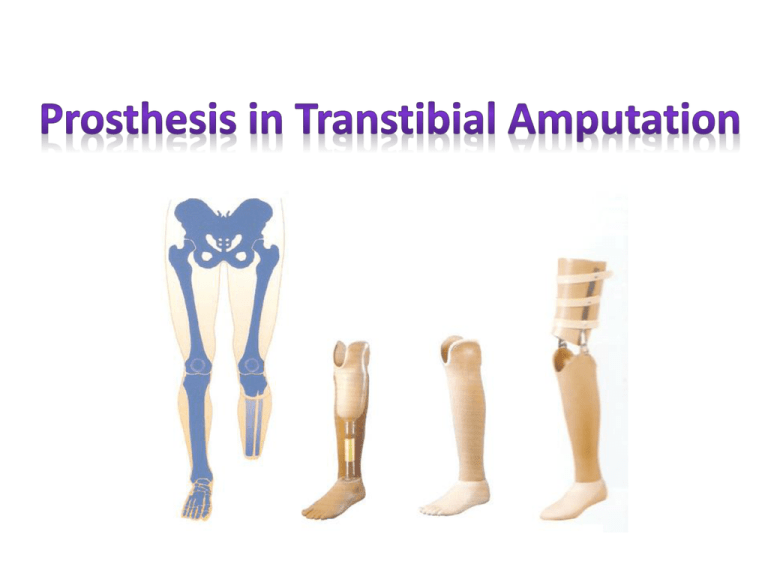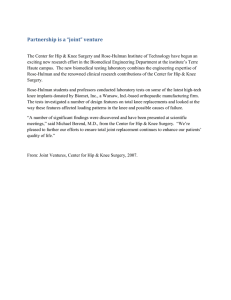Document 15354853
advertisement

Upon completion of this lecture student will be able to: Identify different parts of transtibial prosthesis. Describe the possible gait deviations in transtibial prosthesis. State the advantage of knee disarticulation surgery. Describe different parts of prosthesis in knee disarticulation. • Trans-tibial amputation accounts for 59% of lower limb amputation. • Ideal length of stump is 15 cm from tibial tubercle. • Minimum length is just below tibial tubercle. • Wound healing is inversely proportional to length. • The name of the prosthesis is based on the type of socket. • Parts of transtibial prosthesis includes: 1. Socket 2. Suspension 3. Shin piece 4. Foot piece. • Socket is the part of prosthesis that encloses the stump and forms union between stump and artificial limb. Five types of socket are used. They are: A. Conventional below knee socket B. Patellar tendon bearing socket (PTB socket) C. Patellar tendon bearing supracondylar suprapatellar socket (PTB-SC-SP socket) D. Bent knee socket. E. Slip socket. A. Conventional Below Knee Socket • These were the initial socket used in below knee before the PTB socket. • It is indicated in elderly persons with unstable knee and persons with quadriceps weakness. • It is fabricated in such a way that there is no pressure over distal tibia, head of fibula or tibial crest. 30% of weight by thigh corset. • It consist of a wooden socket, left open at the bottom. • It requires external knee joint with thigh corset for stability and suspension. • The major disadvantages are: Skin irritation from friction Stump chocking with edema over distal end of stump from constriction by the superior portion socket. A. Before Donning • Prosthesis meets specification and prescription. • Inside of the socket is smoothly finished. • Joints if available are freely moving. B. Sitting with Prosthesis • Comfortable • Foot flat on ground • Adequate relief to hamstrings. • Stump fit to socket • Suspension loosens/tightens. • Both knees at level • Color matching to normal limb. C. Standing with Prosthesis • Interface between stump and socket (Too tight/too loose) • Knee stability and knee flexion Too much flexion needs leads to anterior knee pressure. Too little flexion leads to end bearing. • Pelvis on level • Foot flat on standing • Gaping at brim of socket. D. Walking • Check for: Ball of foot more than 2.5 cm from floor. Knee extended on all phases Unequal stride length. 1. Excessive Knee Extension In normal gait the knee flexes 10° to 15° on heel strike. It reduces movement of center of gravity and absorbs floor reaction force. Keeping knee extended increases energy expenditure and patient reports a sense of walking up hill. It also leads to distal pain and skin abrasions. Prosthetic causes: • Heel cushion too soft: No rolling over possible and premature foot flat keeps knee in extension. • Posterior displacement of socket over the foot. • Excessive plantar flexed foot. Amputee causes: • Weakness of quadriceps • Habit pattern. 2. Knee Instability • Heel cushion too hard • Dorsi flexed foot. • High heel shoe. 1. Excessive Raising of Hip Excessive raising of hip on prosthetic side is due to too long prosthesis. 2. Excessive Dropping of Hip Excessive dropping of hip on prosthetic side is due to: Too short prosthesis. Painful stump. 3. Wide Based Gait Support base is moved laterally so patient moves the pelvis and shoulders laterally exhibiting wide based gait. It leads pressure over proximal lateral aspect and distal medial area. Causes: Out set foot: Foot normally set 1 cm medial to a line from the center of posterior wall to floor. If foot is set too lateral to this line it is out set foot. Medial leaning pylon or shank also leads to wide based gait. 4. Narrow Based Gait Inset foot. Lateral leaning of pylon or shank. 1. Drop Off The heel lever arm (back of heel to mid points if foot) provides support from heel strike to mid stance. Mid stance to terminal stance support is provided by to toe lever arm (mid point of foot to tip of toe) this helps the patient to roll over. Just before heel off knee is in extension and at heel off knee flexion begins. This change of extension to flexion coincides with passing of center of gravity over MTP joints. If the body weight is carried over too soon the lack of anterior support leads to premature knee flexion or drop off. Cause: Toe lever arm too short. 2. Knee Extension Vaulting Too long toe lever arm causes extension moment at terminal stance (instead of the normal knee flexion moment at toe off). Patient complaints of walking up hill sensation as the center of gravity is carried up and overextended knee. 1. Pistoning The prosthesis slips as foot leaves the ground in swing phase. Causes: Loose or inadequate suspension. Loose socket. 2. Uneven Step Length Long step with prosthesis and short step with sound leg. Causes: Pain with poor fitting socket. Too long prosthesis. Fear of weight bearing. 3. Circumduction Semicircular swing of prosthesis during swing phase: 1. Too long prosthesis 2. Inadequate suspension 3. Flexor muscle weakness in hip and knee 4. Restricted flexion in hip and knee. 1. 2. 3. 4. 5. End bearing stump. Good rotational control. Good suspension. Less surgical time. Less blood loss.



